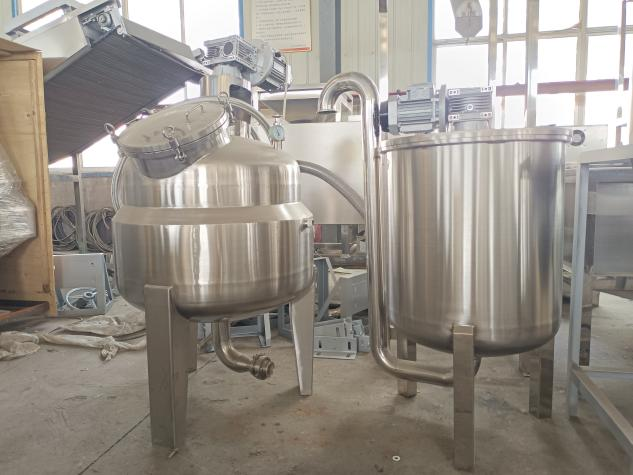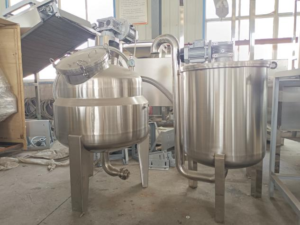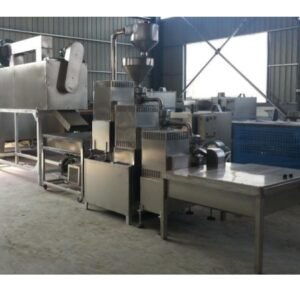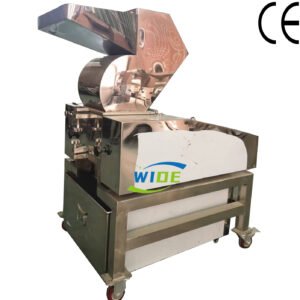Vacuum mixing tank
Vacuum mixing tanks are used for mixing, emulsifying, homogenizing and dissolving ingredients in the food industry.
Description
Introduction
This machines made by stainless steel material, used in the whole butter processing line, volume and functions are customized according to customers’ exact demands.
Mixing tank is a vessel designed to blend or combine different substances or components to create a homogenous mixture. The working process of a mixing tank typically involves the following steps:
1、Preparation: Before starting the mixing process, the tank needs to be prepared. This includes ensuring that the tank is clean and free from any residual material from previous batches. The tank should also be inspected for any damage or leaks.
2、Loading: The substances or components to be mixed are loaded into the tank. This can be done manually or using automated systems such as pumps or conveyors. The order and quantity of loading depend on the specific mixing requirements and the nature of the substances being mixed.
2、Loading: The substances or components to be mixed are loaded into the tank. This can be done manually or using automated systems such as pumps or conveyors. The order and quantity of loading depend on the specific mixing requirements and the nature of the substances being mixed.
3、Mixing: Once the tank is loaded, the mixing process begins. Mixing can be achieved through various mechanisms, such as agitators, impellers, or paddles. These mechanisms are usually powered by electric motors or other sources of mechanical energy. The speed and intensity of mixing can be adjusted based on the desired outcome.
4、Monitoring: During the mixing process, it is important to monitor various parameters to ensure optimal mixing. This may
include temperature, pressure, pH levels, viscosity, or any other relevant factors depending on the nature of the substances
being mixed. Monitoring can be done manually or using automated sensors and control systems.
5、Sampling: Periodically, samples are taken from the mixing tank to check the quality and uniformity of the mixture. These
samples are analyzed in a laboratory or using on-site testing equipment to verify that the desired mixing parameters are being met.Adjustments can be made to the mixing process if necessary.
6、Discharge: Once the mixing process is complete and the desired mixture is achieved, the contents of the tank are discharged.This can be done by opening valves or using pumps or gravity flow, depending on the specific setup. The mixture is typically transferred to a storage container or directly into the next stage of the manufacturing process.
7、Cleaning and Maintenance: After the discharge, the mixing tank needs to be cleaned thoroughly to remove any residue or
leftover material. Regular maintenance of the tank and its components is also important to ensure its proper functioning and longevity.
4、Monitoring: During the mixing process, it is important to monitor various parameters to ensure optimal mixing. This may
include temperature, pressure, pH levels, viscosity, or any other relevant factors depending on the nature of the substances
being mixed. Monitoring can be done manually or using automated sensors and control systems.
5、Sampling: Periodically, samples are taken from the mixing tank to check the quality and uniformity of the mixture. These
samples are analyzed in a laboratory or using on-site testing equipment to verify that the desired mixing parameters are being met.Adjustments can be made to the mixing process if necessary.
6、Discharge: Once the mixing process is complete and the desired mixture is achieved, the contents of the tank are discharged.This can be done by opening valves or using pumps or gravity flow, depending on the specific setup. The mixture is typically transferred to a storage container or directly into the next stage of the manufacturing process.
7、Cleaning and Maintenance: After the discharge, the mixing tank needs to be cleaned thoroughly to remove any residue or
leftover material. Regular maintenance of the tank and its components is also important to ensure its proper functioning and longevity.






